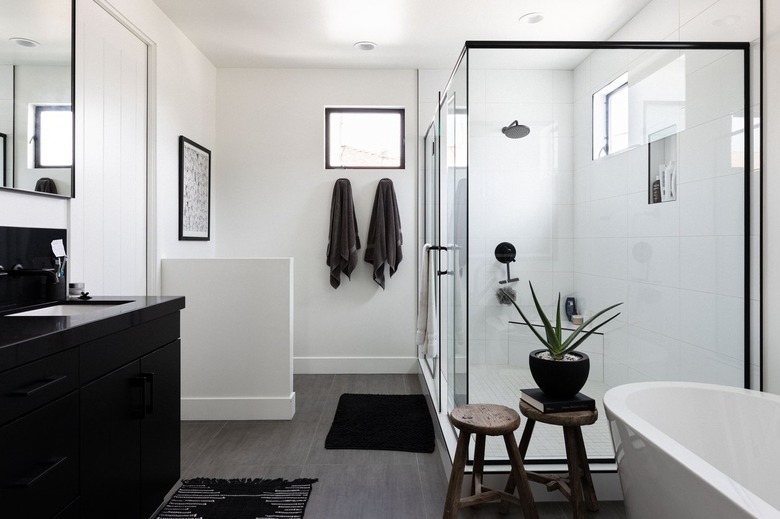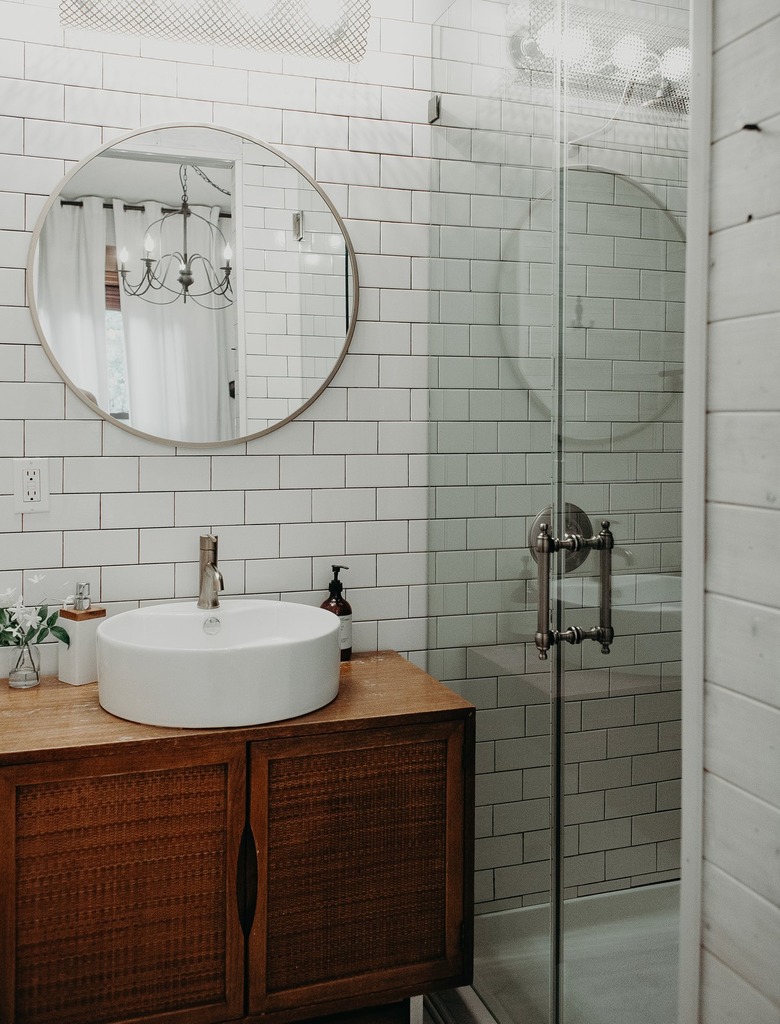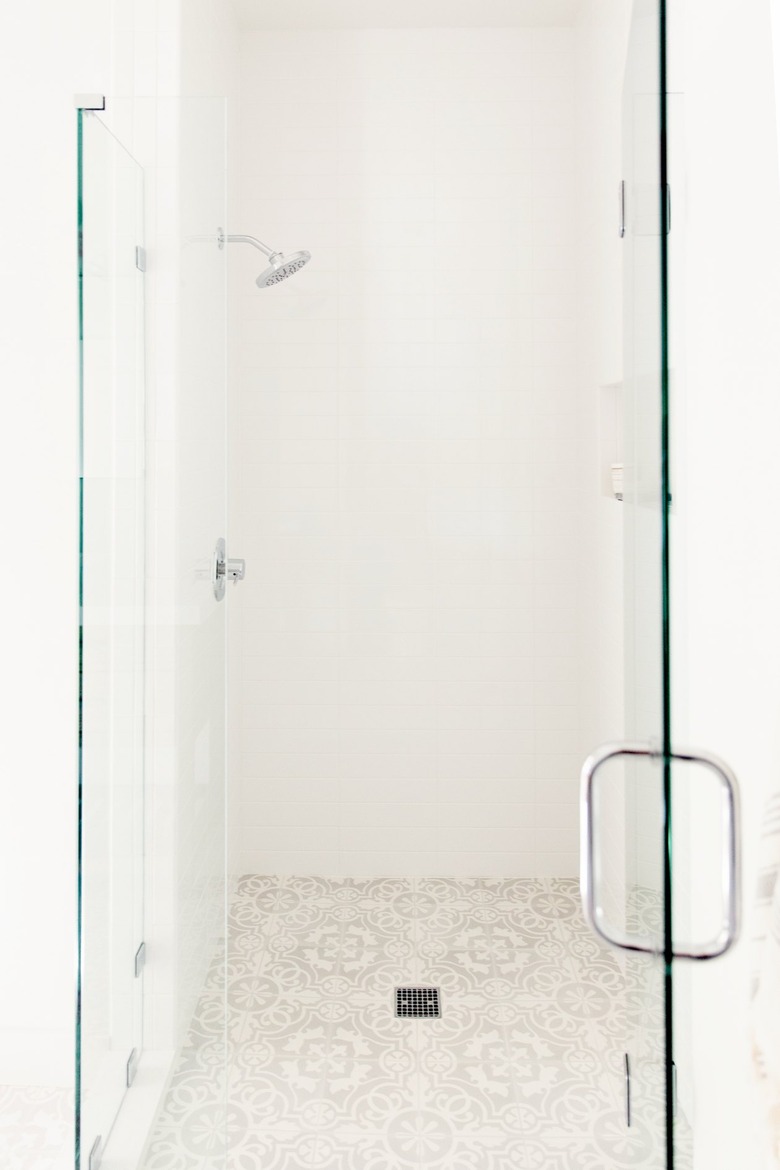How To Find The Source Of A Leaky Shower Drain Or Pan
If there is a stain growing on the ceiling beneath your shower or if you have loose or soggy flooring near the shower, it could mean that you have a leaky shower drain, but it might also be that the shower pan has a leak. Because leaks can come from anywhere, before you can fix the leak and repair whatever damage has been done to your floors, walls and ceiling, you need to determine whether the water is coming from a leaky shower drain or shower pan.
The shower pan is the floor of your shower, and it can be either a prefab pan or a custom-made tiled pan. Prefab pans are manufactured in certain sizes and shapes and can be made of several materials, including fiberglass and acrylic. Custom-made pans can be installed in a large variety of sizes and shapes. While the shower drain is often located in the middle of the shower pan, many pans, especially custom shower pans, feature an offset drain. Shower pans are slightly pitched toward the drain and are designed to keep the water inside the shower and running down the drain.
Reasons for Leaky Shower Pans
Reasons for Leaky Shower Pans
A common cause of a leaky shower pan is movement. The pan should not move at all, but some pans, particularly plastic shower pans, will move a little bit. Even slight movement will cause the base to crack and let water through over time. These cracks are often too small to notice and are only found when there is a water problem below the shower.One other place from which water can leak is over the rim of the shower pan, which should be sealed tight with caulking during installation.
Another reason a shower pan can develop a leak is the normal wear and tear of time. Most everything will wear out over time, and shower pans are no different. Over the years, a pan can develop cracks, and the caulking around the edges can dry up and break apart, allowing water to leak through.
Shower Drain Basics
Shower Drain Basics
The shower drain trap and pipes are connected to the drain at the bottom of the shower with a shower drain assembly. The assembly usually consists of a strainer and a strainer body or flange that are visible from inside the shower. A bead of plumbers' putty or silicone caulk is run around the bottom lip of the strainer flange to seal it against leaks. From the bottom of the shower, the drain body or a nut is screwed onto the strainer body and sealed with a rubber gasket.
A piece of 2-inch pipe is glued into the bottom and drops into the trap, and from there, the water goes down the drain pipe. Common reasons for a leaking shower drain include a worn or damaged rubber gasket, a cracked flange, plumbers' putty that has become dry or brittle or not enough plumbers' putty or silicone. Some drain repairs can be fixed from inside the shower, while others require opening and working inside the ceiling under the shower.
Testing a Shower Drain
Testing a Shower Drain
To check a leaking shower drain, you will need to open up the ceiling below the shower for visible access to the drain. If the shower is on the first floor and you can see it from the basement, you fortunately can skip this step. Remember that water can run down a drain pipe and drip elsewhere, so seeing a stain on the ceiling or a drain pipe dripping somewhere other than under the shower doesn't mean the drain is not leaking.
The good thing about testing a shower drain for a leak is that it is very simple — just wipe the drain pipe to remove all moisture and then turn on the shower and run some water in the drain until you can see the leak. You can also use a bucket or hose to supply more water volume. You don't need to plug the drain and let it sit because the water has already been leaking without having the drain plugged. If you can't find a leak, have someone get in the shower and move around. Sometimes, a leak around the drain assembly only appears when the pan moves, especially a plastic shower pan.
Testing a Shower Pan
Testing a Shower Pan
Testing for a leaky shower pan can take a lot longer than checking the shower drain. First, the drain will need to be plugged. You can do this by removing the drain screen and inserting a plug in the drain or by leaving the screen and taping over it with duct tape. Be sure to use enough tape to completely seal the drain. Then, mark a line on the shower wall 1 inch up from the bottom of the floor pan and fill the shower with water up to the line.
Let the water sit in the shower for at least eight hours and check it for leaks every hour. While the minimum is eight hours, some shower pan leaks can take up to 50 hours before they are visible, according to PlumbingSupply.com. Many people don't have the patience to wait that long, or they can't wait 50 hours between showers. Luckily, most leaks — especially when leaking has occurred for long enough to cause stains or loose flooring — will be visible in eight hours or less.
You may see the water level dropping before then, in which case you definitely have a leak. If you do have a leaky shower pan, the underside of the shower will need to be accessed, sometimes meaning that you will need to open up the ceiling below it in order to determine the source of the leak. Check for dripping or accumulating water. Once the leak is found, you can determine the source and decide how to repair it.


